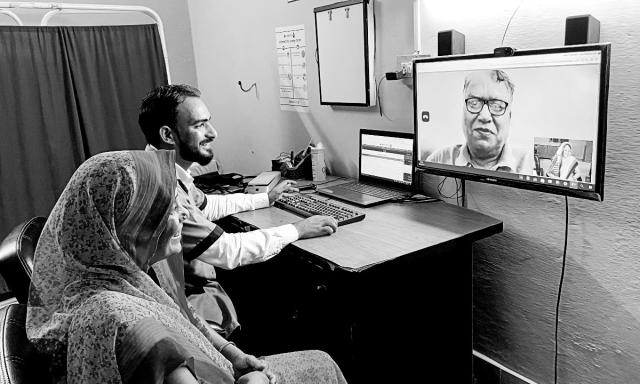

 Article
Article

 SAMRIDH Healthcare Blended Finance Facility improves access to affordable and quality health care for the most socioeconomically vulnerable in India. It leverages philanthropic funding to mitigate barriers for private investment and drive greater commercial investments toward health system strengthening and is a leading public-private partnership.
SAMRIDH Healthcare Blended Finance Facility improves access to affordable and quality health care for the most socioeconomically vulnerable in India. It leverages philanthropic funding to mitigate barriers for private investment and drive greater commercial investments toward health system strengthening and is a leading public-private partnership.

Insights from
Written by
Access to Quality Health Care
In India, public spending in the health sector has been historically low, with the government contributing approximately 1.8 percent of the GDP toward public health care,1 as opposed to the global average of about 10 percent.2 As a result, the country faces a long-standing challenge of weak health systems with a persistent shortage of skilled workforce and infrastructure. Vulnerable populations, including low-income and marginalized communities, are dependent on the overburdened public health care facilities, unaffordable private sector or unskilled providers — leading to poor health outcomes and high out-of-pocket expenditure. Not only do these gaps hinder progress toward India’s health goals, but they also have a ripple effect on achieving other of the United Nations’ sustainable development goals.
These challenges have been exacerbated during the COVID-19 pandemic. Through mid-August 2022, India has reported over 44 million cases and more than 500,000 deaths. At times, the daily new cases went as high as 400,000, pushing health systems to the brink. While the hospitals, clinics and diagnostic laboratories faced the challenge of catering to an increased number of patients, the supply chain and manufacturers needed to quickly ramp up production and supplies. The country had to resort to prolonged lockdowns to augment capacity and bridge the demand-supply gap.
Fortunately, both government and the private sector acted constructively to address these gaps. However, to improve access to affordable and quality health care for the vulnerable, it is estimated that India will need additional investments of $245 billion by 2034, which is significantly higher than current spend levels. Even with major changes, such as the adoption of new technologies and a focus on prevention and wellness, the funding requirement is estimated at $156 billion.3
While the country has a robust innovation ecosystem with over 7,400 registered startups in the health-tech domain,4 multiple challenges limit their ability to scale up, including lack of capital, market access, regulatory roadblocks and market inefficiencies. Since 2010, over 110 private equity and venture capital investors have invested in the health care delivery space in India, with a transaction value of more than $1.2 billion.5 However, these investments have largely gone into tier-1 markets and not necessarily toward improving accessibility and affordability for the vulnerable masses.
Sustainable Access to Market and Resources for Innovative Delivery of Healthcare (SAMRIDH) Blended Finance Facility
SAMRIDH Healthcare Blended Finance Facility, through blended finance models, leverages philanthropic funding to mitigate barriers for private investment and drive greater commercial investments toward health system strengthening.
With the onset of the pandemic, the United States Agency for International Development (USAID)/India established SAMRIDH with the immediate goal to bridge the supply-side gaps in emergency health services and accelerate India’s response to COVID-19. In the long-term, it aims to strengthen comprehensive health services to improve access to affordable and quality health care for the most socioeconomically vulnerable 40 percent of the population (approximately 540 million) and build resilient health systems to effectively respond to future health emergencies.
The initiative has identified the following key objectives to achieve by September 2023:
SAMRIDH follows a systematic evaluation approach to identify high-impact health solutions and uses blended finance models to mobilize grants and facilitate debt funding support to health care businesses. In addition, it has built networks to provide proven health solutions, market access, business advisory services and technical assistance to advance their expansion and sustainability plans. To implement this multipronged approach, SAMRIDH has catalyzed diverse partnerships with over 100 ecosystem players from the government, financial institutions, philanthropies, incubators, academia and industry associations.
It has a robust governance structure in form of an Advisory Committee, which provides oversight and guides the efficient disbursement of funding, ensuring the funded solutions are sustainable in the medium and long term. The Advisory Committee is constituted of senior bureaucrats, experts from Atal Innovation Mission, NITI Aayog, Principal Scientific Advisor Office of Government of India (GoI), IIT-Delhi, Rockefeller Foundation and IndusInd Bank.
Two years into the journey, SAMRIDH has:
SAMRIDH is paving the way to create a conducive ecosystem for scaling-up market-based health care solutions targeted to improve health care services for vulnerable communities. Through initiatives addressing issues including the capacity and training of the workforce, infrastructure, diagnostic products and services, medical devices, vaccine supply and delivery systems, SAMRIDH has made significant advancements toward strengthening the access, quality and responsiveness of health care deliver yin the country.
The world has a financing gap estimated at trillions of dollars annually to achieve the United Nations’ sustainable development goals (SDGs). The challenge is that conventional private investors consider addressing these needs either too risky or offering poor returns, and the COVID-19 pandemic has only made the situation more pressing, particularly in health care. One solution is “blended finance,” defined as structures that combine public development finance by multilateral agencies and grants by philanthropic organizations to attract more private capital toward deals targeting the SDG goal No. 3 (good health and well-being) in developing countries.
India is a country with many unmet health care capacity and infrastructure needs, and the pandemic further raised the urgency of these needs. This is a high-impact sector in which the SAMRIDH initiative can help mobilize additional finance; this tri-sector collaboration uses innovative financial tools. One such example is its use of blended finance to combine development funding from public and philanthropic entities that have concessional or below-market terms (such as grants or providing loan guarantees with project risk absorbed) and private capital that earns market-rate returns (at lower risk) to deliver both financial and social outcomes and make projects viable.
Though blended finance can only be part of addressing the financing gap puzzle, initiatives such that SAMRIDH are building good momentum to improve access to affordable and quality health care services for low-income and vulnerable populations.
The Darden School of Business’ Institute for Business in Society partners with Concordia and the U.S. Department of State Secretary’s Office of Global Partnerships to present the annual P3 Impact Award, which recognizes leading public-private partnerships that improve communities around the world. This year’s award will be presented at the Concordia Annual Summit the week of 19 September 2022. The five finalists will be highlighted on Darden Ideas to Action on Fridays leading up to the event.
This article was developed with the support of Darden’s Institute for Business in Society, at which Maggie Morse is director of programs.
Matos is an expert in the fields of asset management, investments, corporate governance and international finance. His research focuses on international corporate governance and the growing importance of institutional investors in financial markets worldwide.
Before Darden, Matos served as an economist for the Portuguese Ministry of Finance and as a consultant for the World Bank in Washington, D.C., and taught at the University of Southern California. He is a research associate at the European Corporate Governance Institute.
Matos is one of the authors of “Are US CEOs Paid More? New International Evidence,” published in February of 2013 in The Review of Financial Studies.
B.A., Universidade Nova de Lisboa; M.S., IST Universidade Tecnica de Lisboa and INSEAD; Ph.D., INSEAD
SAMRIDH: Using Blended Finance Toward Quality Health Care in India